BNM - BUS5001 Managing Across Cultures: Cultural Impact Analysis
VerifiedAdded on 2023/06/12
|16
|5346
|88
Report
AI Summary
This report explores the critical role of understanding national culture in the context of international management, emphasizing its impact on various business functions. It delves into the concept and scope of national culture, highlighting its significance in international business operations, including joint ventures, mergers, and acquisitions. The report further examines the influence of cross-cultural understanding on managing global virtual teams, referencing Trompenaars' seven dimensions of culture to illustrate cultural differences and their effects on leadership, motivation, negotiation, communication, and decision-making within organizations. Ultimately, the report underscores the importance of effective cross-cultural management for achieving success and growth in the international market.
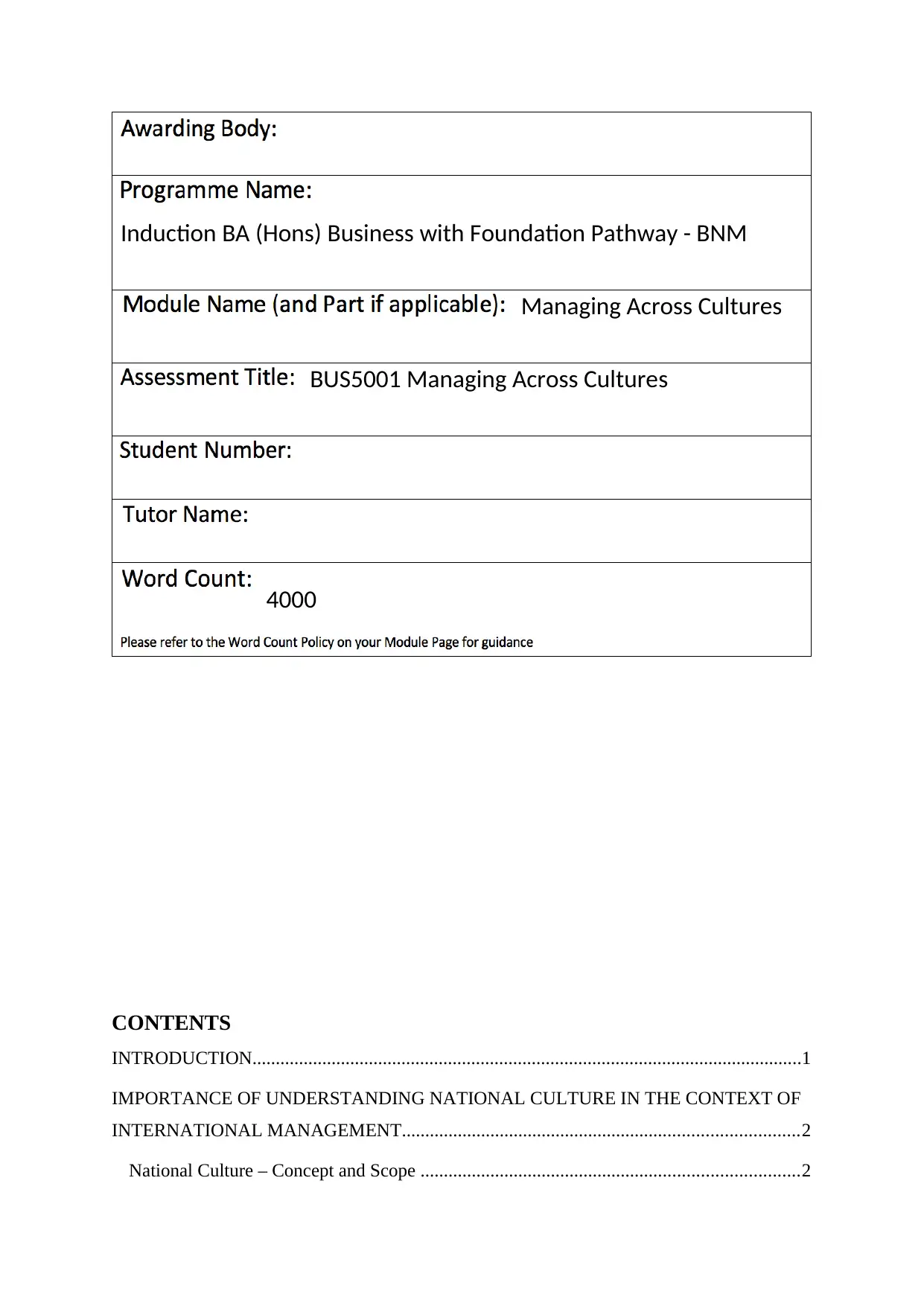
Induction BA (Hons) Business with Foundation Pathway - BNM
Managing Across Cultures
BUS5001 Managing Across Cultures
4000
CONTENTS
INTRODUCTION......................................................................................................................1
IMPORTANCE OF UNDERSTANDING NATIONAL CULTURE IN THE CONTEXT OF
INTERNATIONAL MANAGEMENT.....................................................................................2
National Culture – Concept and Scope .................................................................................2
Managing Across Cultures
BUS5001 Managing Across Cultures
4000
CONTENTS
INTRODUCTION......................................................................................................................1
IMPORTANCE OF UNDERSTANDING NATIONAL CULTURE IN THE CONTEXT OF
INTERNATIONAL MANAGEMENT.....................................................................................2
National Culture – Concept and Scope .................................................................................2
Paraphrase This Document
Need a fresh take? Get an instant paraphrase of this document with our AI Paraphraser

Significance of national culture to international management...............................................3
IMPACT OF UNDERSTANDING OF CROSS-CULTURE ON MANAGEMENT OF
GLOBAL VIRTUAL TEAMS..................................................................................................5
NOTION OF CULTURAL DIFFERENCES.............................................................................9
CONCLUSION........................................................................................................................11
REFERENCES & BIBLIOGRAPHY......................................................................................12
IMPACT OF UNDERSTANDING OF CROSS-CULTURE ON MANAGEMENT OF
GLOBAL VIRTUAL TEAMS..................................................................................................5
NOTION OF CULTURAL DIFFERENCES.............................................................................9
CONCLUSION........................................................................................................................11
REFERENCES & BIBLIOGRAPHY......................................................................................12
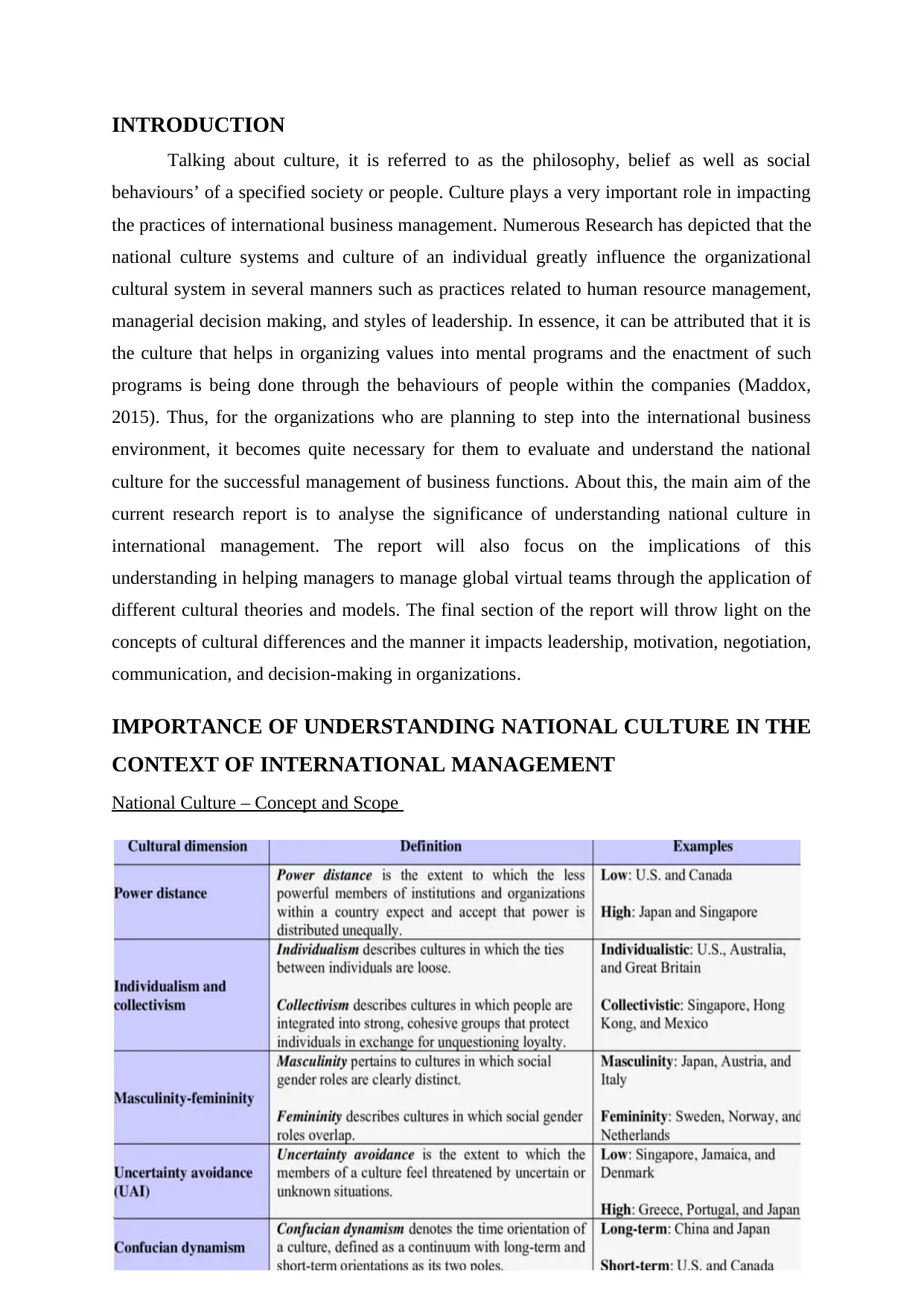
INTRODUCTION
Talking about culture, it is referred to as the philosophy, belief as well as social
behaviours’ of a specified society or people. Culture plays a very important role in impacting
the practices of international business management. Numerous Research has depicted that the
national culture systems and culture of an individual greatly influence the organizational
cultural system in several manners such as practices related to human resource management,
managerial decision making, and styles of leadership. In essence, it can be attributed that it is
the culture that helps in organizing values into mental programs and the enactment of such
programs is being done through the behaviours of people within the companies (Maddox,
2015). Thus, for the organizations who are planning to step into the international business
environment, it becomes quite necessary for them to evaluate and understand the national
culture for the successful management of business functions. About this, the main aim of the
current research report is to analyse the significance of understanding national culture in
international management. The report will also focus on the implications of this
understanding in helping managers to manage global virtual teams through the application of
different cultural theories and models. The final section of the report will throw light on the
concepts of cultural differences and the manner it impacts leadership, motivation, negotiation,
communication, and decision-making in organizations.
IMPORTANCE OF UNDERSTANDING NATIONAL CULTURE IN THE
CONTEXT OF INTERNATIONAL MANAGEMENT
National Culture – Concept and Scope
1
Talking about culture, it is referred to as the philosophy, belief as well as social
behaviours’ of a specified society or people. Culture plays a very important role in impacting
the practices of international business management. Numerous Research has depicted that the
national culture systems and culture of an individual greatly influence the organizational
cultural system in several manners such as practices related to human resource management,
managerial decision making, and styles of leadership. In essence, it can be attributed that it is
the culture that helps in organizing values into mental programs and the enactment of such
programs is being done through the behaviours of people within the companies (Maddox,
2015). Thus, for the organizations who are planning to step into the international business
environment, it becomes quite necessary for them to evaluate and understand the national
culture for the successful management of business functions. About this, the main aim of the
current research report is to analyse the significance of understanding national culture in
international management. The report will also focus on the implications of this
understanding in helping managers to manage global virtual teams through the application of
different cultural theories and models. The final section of the report will throw light on the
concepts of cultural differences and the manner it impacts leadership, motivation, negotiation,
communication, and decision-making in organizations.
IMPORTANCE OF UNDERSTANDING NATIONAL CULTURE IN THE
CONTEXT OF INTERNATIONAL MANAGEMENT
National Culture – Concept and Scope
1
⊘ This is a preview!⊘
Do you want full access?
Subscribe today to unlock all pages.

Trusted by 1+ million students worldwide

Source: Fig.1 (Hofstede’s-cultural-dimensions-theory 2021).
Speaking about culture, it is being referred to as the obtained understanding which the people
make use for interpreting their experience as well as for generation their communal behaviour. It is
also crucial to know that culture is grasped and supports people in their efforts of communicating and
interacting with the other individual in the community. It becomes quite difficult for individuals to
adjust and comprehend when they are being placed in a culture wherein there are different beliefs and
values. Therefore, the managers must comprehend the differences in culture, and they must be
sensitive towards them for attaining a high degree of success and growth in the international market.
There is a different definition of culture being given by different authors. According to Terpstra and
David (2016), culture is being referred to as a shared, learned, compelled as well as, and
interconnected set of symbols whose meanings offer an established orientation for the society
members. As per Mendenhall (2015), there are some crucial components of culture, for example,
dynamics, social structure, space and time orientation, human nature viewpoint, language, and roles of
gender. This array of symbols, ideas, viewpoints, and values are brought into definition by Hofstede
(1994), and he discusses collective metal programming. In simple words, it can be said that culture is
nothing but the amalgamation of obtained knowledge, beliefs that are fed into the behaviour
and impact the responses of diversified groups.
Several investigators have studied the role of national culture in shaping the working
environment of the organization and many other social institutions. Culture is all that each
share with the members of other nations, caste, religion, and groups (Johnson and Turner,
2015). Furthermore, it encompasses different values which are being shared amid people in a
specified communal arrangement with explicit nationality or country of origin. Besides,
culture is developed, obtained, learned, and distributed through a group of people whether
deliberately or automatically to the next generation. The culture of a particular nation offers a
wide context in which the other manifestations of culture such as occupation, religion, region,
and organizational culture take place. Moreover, many of these reference points of culture
also possess a measurement of cross-border. For illustration, Catholics are subject to the same
kind of effects whether they are Portuguese, Mexican, or Italian. Nevertheless, the influence
of these dissimilarities will differ nationwide as well as additional challenging ethnic factors.
Therefore, overall, it can be said that culture is the learned phenomenon and the result of
communal involvement more than years which are being passed down to generations.
Significance of national culture to international management
When talking about international business management, culture has a huge role to
play. When a company is planning to enter a new market, they require comprehension of
2
Speaking about culture, it is being referred to as the obtained understanding which the people
make use for interpreting their experience as well as for generation their communal behaviour. It is
also crucial to know that culture is grasped and supports people in their efforts of communicating and
interacting with the other individual in the community. It becomes quite difficult for individuals to
adjust and comprehend when they are being placed in a culture wherein there are different beliefs and
values. Therefore, the managers must comprehend the differences in culture, and they must be
sensitive towards them for attaining a high degree of success and growth in the international market.
There is a different definition of culture being given by different authors. According to Terpstra and
David (2016), culture is being referred to as a shared, learned, compelled as well as, and
interconnected set of symbols whose meanings offer an established orientation for the society
members. As per Mendenhall (2015), there are some crucial components of culture, for example,
dynamics, social structure, space and time orientation, human nature viewpoint, language, and roles of
gender. This array of symbols, ideas, viewpoints, and values are brought into definition by Hofstede
(1994), and he discusses collective metal programming. In simple words, it can be said that culture is
nothing but the amalgamation of obtained knowledge, beliefs that are fed into the behaviour
and impact the responses of diversified groups.
Several investigators have studied the role of national culture in shaping the working
environment of the organization and many other social institutions. Culture is all that each
share with the members of other nations, caste, religion, and groups (Johnson and Turner,
2015). Furthermore, it encompasses different values which are being shared amid people in a
specified communal arrangement with explicit nationality or country of origin. Besides,
culture is developed, obtained, learned, and distributed through a group of people whether
deliberately or automatically to the next generation. The culture of a particular nation offers a
wide context in which the other manifestations of culture such as occupation, religion, region,
and organizational culture take place. Moreover, many of these reference points of culture
also possess a measurement of cross-border. For illustration, Catholics are subject to the same
kind of effects whether they are Portuguese, Mexican, or Italian. Nevertheless, the influence
of these dissimilarities will differ nationwide as well as additional challenging ethnic factors.
Therefore, overall, it can be said that culture is the learned phenomenon and the result of
communal involvement more than years which are being passed down to generations.
Significance of national culture to international management
When talking about international business management, culture has a huge role to
play. When a company is planning to enter a new market, they require comprehension of
2
Paraphrase This Document
Need a fresh take? Get an instant paraphrase of this document with our AI Paraphraser
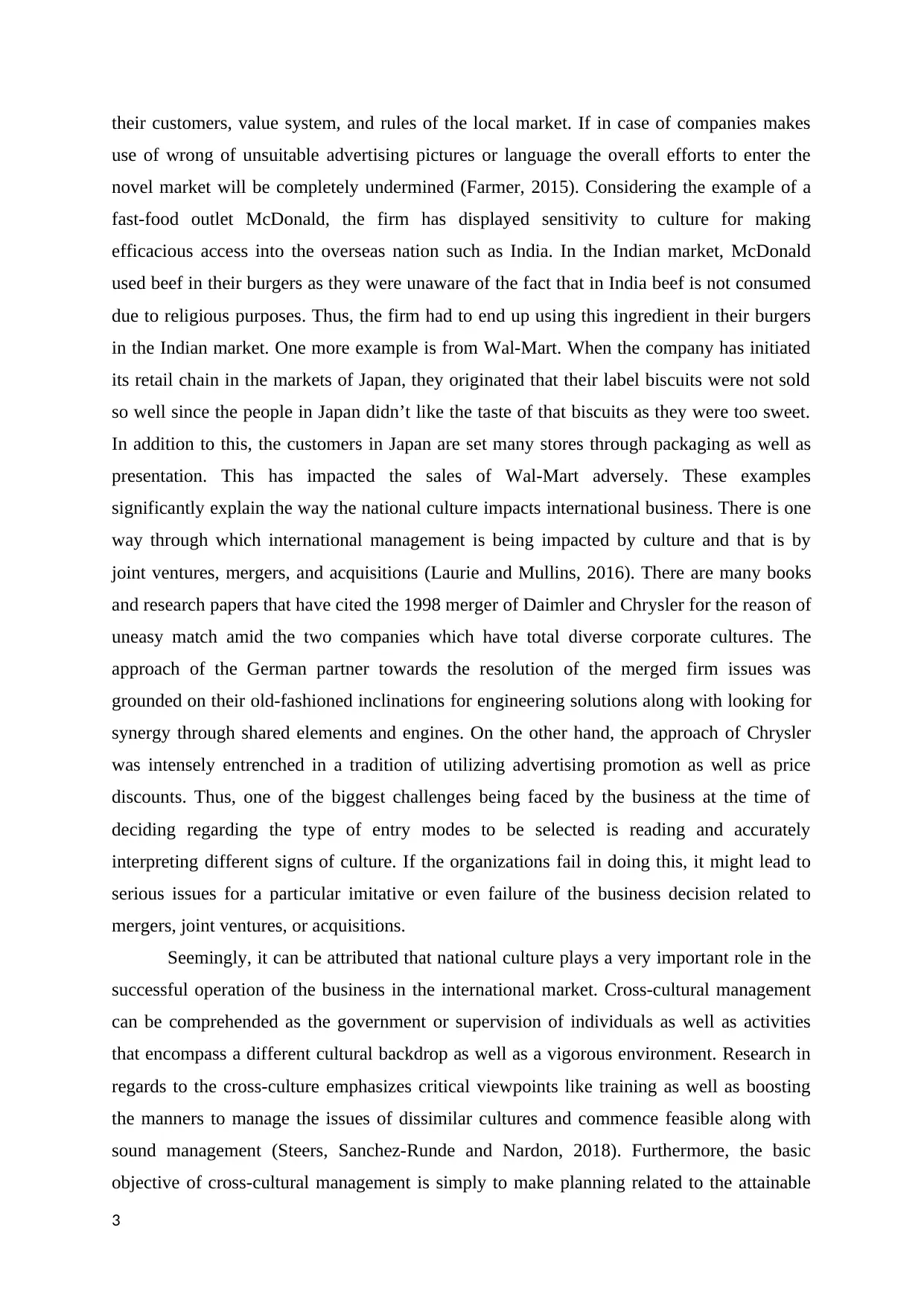
their customers, value system, and rules of the local market. If in case of companies makes
use of wrong of unsuitable advertising pictures or language the overall efforts to enter the
novel market will be completely undermined (Farmer, 2015). Considering the example of a
fast-food outlet McDonald, the firm has displayed sensitivity to culture for making
efficacious access into the overseas nation such as India. In the Indian market, McDonald
used beef in their burgers as they were unaware of the fact that in India beef is not consumed
due to religious purposes. Thus, the firm had to end up using this ingredient in their burgers
in the Indian market. One more example is from Wal-Mart. When the company has initiated
its retail chain in the markets of Japan, they originated that their label biscuits were not sold
so well since the people in Japan didn’t like the taste of that biscuits as they were too sweet.
In addition to this, the customers in Japan are set many stores through packaging as well as
presentation. This has impacted the sales of Wal-Mart adversely. These examples
significantly explain the way the national culture impacts international business. There is one
way through which international management is being impacted by culture and that is by
joint ventures, mergers, and acquisitions (Laurie and Mullins, 2016). There are many books
and research papers that have cited the 1998 merger of Daimler and Chrysler for the reason of
uneasy match amid the two companies which have total diverse corporate cultures. The
approach of the German partner towards the resolution of the merged firm issues was
grounded on their old-fashioned inclinations for engineering solutions along with looking for
synergy through shared elements and engines. On the other hand, the approach of Chrysler
was intensely entrenched in a tradition of utilizing advertising promotion as well as price
discounts. Thus, one of the biggest challenges being faced by the business at the time of
deciding regarding the type of entry modes to be selected is reading and accurately
interpreting different signs of culture. If the organizations fail in doing this, it might lead to
serious issues for a particular imitative or even failure of the business decision related to
mergers, joint ventures, or acquisitions.
Seemingly, it can be attributed that national culture plays a very important role in the
successful operation of the business in the international market. Cross-cultural management
can be comprehended as the government or supervision of individuals as well as activities
that encompass a different cultural backdrop as well as a vigorous environment. Research in
regards to the cross-culture emphasizes critical viewpoints like training as well as boosting
the manners to manage the issues of dissimilar cultures and commence feasible along with
sound management (Steers, Sanchez-Runde and Nardon, 2018). Furthermore, the basic
objective of cross-cultural management is simply to make planning related to the attainable
3
use of wrong of unsuitable advertising pictures or language the overall efforts to enter the
novel market will be completely undermined (Farmer, 2015). Considering the example of a
fast-food outlet McDonald, the firm has displayed sensitivity to culture for making
efficacious access into the overseas nation such as India. In the Indian market, McDonald
used beef in their burgers as they were unaware of the fact that in India beef is not consumed
due to religious purposes. Thus, the firm had to end up using this ingredient in their burgers
in the Indian market. One more example is from Wal-Mart. When the company has initiated
its retail chain in the markets of Japan, they originated that their label biscuits were not sold
so well since the people in Japan didn’t like the taste of that biscuits as they were too sweet.
In addition to this, the customers in Japan are set many stores through packaging as well as
presentation. This has impacted the sales of Wal-Mart adversely. These examples
significantly explain the way the national culture impacts international business. There is one
way through which international management is being impacted by culture and that is by
joint ventures, mergers, and acquisitions (Laurie and Mullins, 2016). There are many books
and research papers that have cited the 1998 merger of Daimler and Chrysler for the reason of
uneasy match amid the two companies which have total diverse corporate cultures. The
approach of the German partner towards the resolution of the merged firm issues was
grounded on their old-fashioned inclinations for engineering solutions along with looking for
synergy through shared elements and engines. On the other hand, the approach of Chrysler
was intensely entrenched in a tradition of utilizing advertising promotion as well as price
discounts. Thus, one of the biggest challenges being faced by the business at the time of
deciding regarding the type of entry modes to be selected is reading and accurately
interpreting different signs of culture. If the organizations fail in doing this, it might lead to
serious issues for a particular imitative or even failure of the business decision related to
mergers, joint ventures, or acquisitions.
Seemingly, it can be attributed that national culture plays a very important role in the
successful operation of the business in the international market. Cross-cultural management
can be comprehended as the government or supervision of individuals as well as activities
that encompass a different cultural backdrop as well as a vigorous environment. Research in
regards to the cross-culture emphasizes critical viewpoints like training as well as boosting
the manners to manage the issues of dissimilar cultures and commence feasible along with
sound management (Steers, Sanchez-Runde and Nardon, 2018). Furthermore, the basic
objective of cross-cultural management is simply to make planning related to the attainable
3

structure of management and element of the executive over the distinctive basis of culture.
Moreover, it similarly plans to make use of attempt’s resource especially the application of
probable approximation of activities positively as well as competently. When talking about
the importance of knowledge about culture in the field of international business, there can be
noticeable varied aspects as well as facets. Some companies require more awareness about
cross-cultural in comparison with other companies. Additionally, there are many nations as
well which also need more strong sensitivity towards cross-culture and security as compared
to the other nations. Similarly, some functions also require a high amount of focussed
awareness about cross-culture in comparison with others. Due to the opposing role as well as
personalities, some people require a high level of cultural insight as compared to others
(Nicolaidis, 2016). Subsequently, it can be said that effective management of cross-culture is
quite imperative when firms operate in the international market as with this management
only, they can attain higher growth and success in international business.
IMPACT OF UNDERSTANDING OF CROSS-CULTURE ON
MANAGEMENT OF GLOBAL VIRTUAL TEAMS
In this current fast-paced financial world, the boundaries of the nations are losing
more and more significance because of the increasing inter-connectedness of the business
constantly. Thus, firms are growing distinctly, particularly in terms of employees. Now the
workplaces are becoming more and more complex and dynamic as different people from
different cultural backgrounds and working style are performing together. And this has
resulted in increasing requirement for cross-cultural management. Fons Trompenaars and
Charles Hampden-
Turner in the year
1977 has determined
the seven dimensions
of culture and model
and was published in
their book as well
(Trompenaars and
Hampden-Turner,
1997). The authors
have found out that people who belong to varied cultures are not just varied from others
rather they are different and predictable manners happen as each culture has its unique
4
Moreover, it similarly plans to make use of attempt’s resource especially the application of
probable approximation of activities positively as well as competently. When talking about
the importance of knowledge about culture in the field of international business, there can be
noticeable varied aspects as well as facets. Some companies require more awareness about
cross-cultural in comparison with other companies. Additionally, there are many nations as
well which also need more strong sensitivity towards cross-culture and security as compared
to the other nations. Similarly, some functions also require a high amount of focussed
awareness about cross-culture in comparison with others. Due to the opposing role as well as
personalities, some people require a high level of cultural insight as compared to others
(Nicolaidis, 2016). Subsequently, it can be said that effective management of cross-culture is
quite imperative when firms operate in the international market as with this management
only, they can attain higher growth and success in international business.
IMPACT OF UNDERSTANDING OF CROSS-CULTURE ON
MANAGEMENT OF GLOBAL VIRTUAL TEAMS
In this current fast-paced financial world, the boundaries of the nations are losing
more and more significance because of the increasing inter-connectedness of the business
constantly. Thus, firms are growing distinctly, particularly in terms of employees. Now the
workplaces are becoming more and more complex and dynamic as different people from
different cultural backgrounds and working style are performing together. And this has
resulted in increasing requirement for cross-cultural management. Fons Trompenaars and
Charles Hampden-
Turner in the year
1977 has determined
the seven dimensions
of culture and model
and was published in
their book as well
(Trompenaars and
Hampden-Turner,
1997). The authors
have found out that people who belong to varied cultures are not just varied from others
rather they are different and predictable manners happen as each culture has its unique
4
⊘ This is a preview!⊘
Do you want full access?
Subscribe today to unlock all pages.

Trusted by 1+ million students worldwide
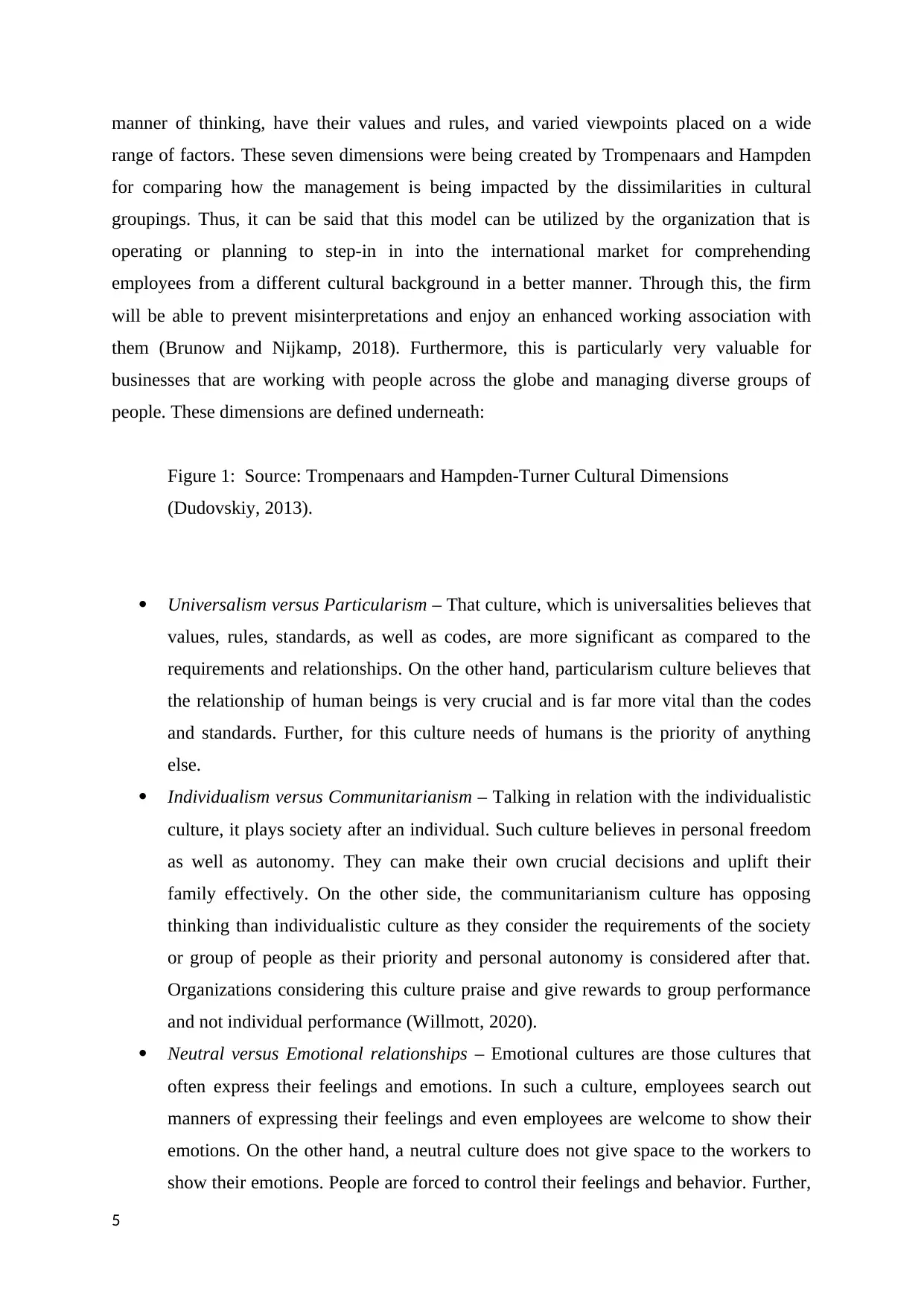
manner of thinking, have their values and rules, and varied viewpoints placed on a wide
range of factors. These seven dimensions were being created by Trompenaars and Hampden
for comparing how the management is being impacted by the dissimilarities in cultural
groupings. Thus, it can be said that this model can be utilized by the organization that is
operating or planning to step-in in into the international market for comprehending
employees from a different cultural background in a better manner. Through this, the firm
will be able to prevent misinterpretations and enjoy an enhanced working association with
them (Brunow and Nijkamp, 2018). Furthermore, this is particularly very valuable for
businesses that are working with people across the globe and managing diverse groups of
people. These dimensions are defined underneath:
Figure 1: Source: Trompenaars and Hampden-Turner Cultural Dimensions
(Dudovskiy, 2013).
Universalism versus Particularism – That culture, which is universalities believes that
values, rules, standards, as well as codes, are more significant as compared to the
requirements and relationships. On the other hand, particularism culture believes that
the relationship of human beings is very crucial and is far more vital than the codes
and standards. Further, for this culture needs of humans is the priority of anything
else.
Individualism versus Communitarianism – Talking in relation with the individualistic
culture, it plays society after an individual. Such culture believes in personal freedom
as well as autonomy. They can make their own crucial decisions and uplift their
family effectively. On the other side, the communitarianism culture has opposing
thinking than individualistic culture as they consider the requirements of the society
or group of people as their priority and personal autonomy is considered after that.
Organizations considering this culture praise and give rewards to group performance
and not individual performance (Willmott, 2020).
Neutral versus Emotional relationships – Emotional cultures are those cultures that
often express their feelings and emotions. In such a culture, employees search out
manners of expressing their feelings and even employees are welcome to show their
emotions. On the other hand, a neutral culture does not give space to the workers to
show their emotions. People are forced to control their feelings and behavior. Further,
5
range of factors. These seven dimensions were being created by Trompenaars and Hampden
for comparing how the management is being impacted by the dissimilarities in cultural
groupings. Thus, it can be said that this model can be utilized by the organization that is
operating or planning to step-in in into the international market for comprehending
employees from a different cultural background in a better manner. Through this, the firm
will be able to prevent misinterpretations and enjoy an enhanced working association with
them (Brunow and Nijkamp, 2018). Furthermore, this is particularly very valuable for
businesses that are working with people across the globe and managing diverse groups of
people. These dimensions are defined underneath:
Figure 1: Source: Trompenaars and Hampden-Turner Cultural Dimensions
(Dudovskiy, 2013).
Universalism versus Particularism – That culture, which is universalities believes that
values, rules, standards, as well as codes, are more significant as compared to the
requirements and relationships. On the other hand, particularism culture believes that
the relationship of human beings is very crucial and is far more vital than the codes
and standards. Further, for this culture needs of humans is the priority of anything
else.
Individualism versus Communitarianism – Talking in relation with the individualistic
culture, it plays society after an individual. Such culture believes in personal freedom
as well as autonomy. They can make their own crucial decisions and uplift their
family effectively. On the other side, the communitarianism culture has opposing
thinking than individualistic culture as they consider the requirements of the society
or group of people as their priority and personal autonomy is considered after that.
Organizations considering this culture praise and give rewards to group performance
and not individual performance (Willmott, 2020).
Neutral versus Emotional relationships – Emotional cultures are those cultures that
often express their feelings and emotions. In such a culture, employees search out
manners of expressing their feelings and even employees are welcome to show their
emotions. On the other hand, a neutral culture does not give space to the workers to
show their emotions. People are forced to control their feelings and behavior. Further,
5
Paraphrase This Document
Need a fresh take? Get an instant paraphrase of this document with our AI Paraphraser

such a culture believes that reasons impact the actions more than the feelings.
Employees must watch out for their body language and must ensure that it does not
depict any kind of negative emotion.
Specific versus Diffuse Relationships – Talking about a specific culture, is being
referred to as the culture in which personal as well as work-life are being kept
separate. They also think that association does not highly impact work performance
although it is crucial to have an association. On the other side, the diffusive culture
sees an overlap amid personal as well as work-life (Bird and Mendenhall, 2016). Such
culture is of the view that for meeting out the objectives of the business, good
association within the people in the organization is very necessary. Furthermore, such
a culture also evaluates the issues effectively overall because they think that all the
problems are connected in the firm.
Achievement versus Ascription – In the achievement type of culture, employees are
being respected and regarded based on their knowledge, achievements, and things
being done by them. Organizations following such culture will never matter what an
individual employee is rather they are concerned about the performance. On contrary,
ascription culture values individual employees and not their performance. Power, job
titles, and positions are considered in such type of culture and all these roles
significantly define the behaviors of people.
Sequential time versus Synchronous time – A company following sequential time
culture is more likely to like events that take place in a particular order. Moreover, a
high level of focus is being placed on punctuality and sticking to the plans with no
variation (Willmott, 2020). Such a firm follows an effective schedule and those
workers who do not follows the same are thrown out of the company. On the other
hand, synchronous time culture is the opposite of sequential time as such
organizations look at current, past as well as future as inter-connected phases. Most of
the time, such companies work on a single project and consider plans as well as
commitment as flexible.
Internal direction versus Outer direction – Organizations considering the internal
direction believe that people can control the nature of the environment for achieving
the desired objectives. This typically encompasses the way they carry out their work
with a group of people and in the company. On the other side, outer direction culture
is strikingly different as companies following such culture believe that nature along
with the environment cannot be controlled by people instead, they control them.
6
Employees must watch out for their body language and must ensure that it does not
depict any kind of negative emotion.
Specific versus Diffuse Relationships – Talking about a specific culture, is being
referred to as the culture in which personal as well as work-life are being kept
separate. They also think that association does not highly impact work performance
although it is crucial to have an association. On the other side, the diffusive culture
sees an overlap amid personal as well as work-life (Bird and Mendenhall, 2016). Such
culture is of the view that for meeting out the objectives of the business, good
association within the people in the organization is very necessary. Furthermore, such
a culture also evaluates the issues effectively overall because they think that all the
problems are connected in the firm.
Achievement versus Ascription – In the achievement type of culture, employees are
being respected and regarded based on their knowledge, achievements, and things
being done by them. Organizations following such culture will never matter what an
individual employee is rather they are concerned about the performance. On contrary,
ascription culture values individual employees and not their performance. Power, job
titles, and positions are considered in such type of culture and all these roles
significantly define the behaviors of people.
Sequential time versus Synchronous time – A company following sequential time
culture is more likely to like events that take place in a particular order. Moreover, a
high level of focus is being placed on punctuality and sticking to the plans with no
variation (Willmott, 2020). Such a firm follows an effective schedule and those
workers who do not follows the same are thrown out of the company. On the other
hand, synchronous time culture is the opposite of sequential time as such
organizations look at current, past as well as future as inter-connected phases. Most of
the time, such companies work on a single project and consider plans as well as
commitment as flexible.
Internal direction versus Outer direction – Organizations considering the internal
direction believe that people can control the nature of the environment for achieving
the desired objectives. This typically encompasses the way they carry out their work
with a group of people and in the company. On the other side, outer direction culture
is strikingly different as companies following such culture believe that nature along
with the environment cannot be controlled by people instead, they control them.
6
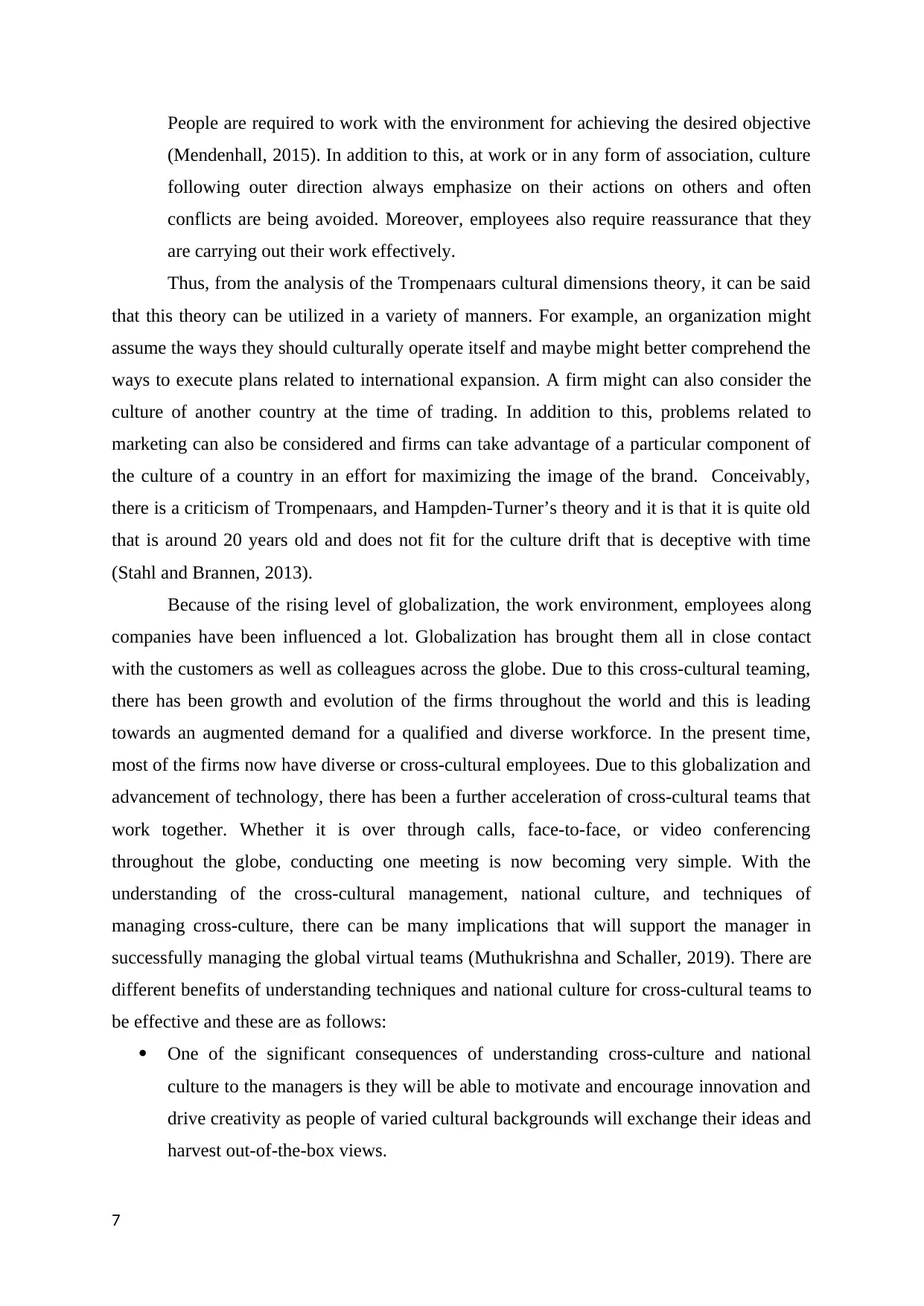
People are required to work with the environment for achieving the desired objective
(Mendenhall, 2015). In addition to this, at work or in any form of association, culture
following outer direction always emphasize on their actions on others and often
conflicts are being avoided. Moreover, employees also require reassurance that they
are carrying out their work effectively.
Thus, from the analysis of the Trompenaars cultural dimensions theory, it can be said
that this theory can be utilized in a variety of manners. For example, an organization might
assume the ways they should culturally operate itself and maybe might better comprehend the
ways to execute plans related to international expansion. A firm might can also consider the
culture of another country at the time of trading. In addition to this, problems related to
marketing can also be considered and firms can take advantage of a particular component of
the culture of a country in an effort for maximizing the image of the brand. Conceivably,
there is a criticism of Trompenaars, and Hampden-Turner’s theory and it is that it is quite old
that is around 20 years old and does not fit for the culture drift that is deceptive with time
(Stahl and Brannen, 2013).
Because of the rising level of globalization, the work environment, employees along
companies have been influenced a lot. Globalization has brought them all in close contact
with the customers as well as colleagues across the globe. Due to this cross-cultural teaming,
there has been growth and evolution of the firms throughout the world and this is leading
towards an augmented demand for a qualified and diverse workforce. In the present time,
most of the firms now have diverse or cross-cultural employees. Due to this globalization and
advancement of technology, there has been a further acceleration of cross-cultural teams that
work together. Whether it is over through calls, face-to-face, or video conferencing
throughout the globe, conducting one meeting is now becoming very simple. With the
understanding of the cross-cultural management, national culture, and techniques of
managing cross-culture, there can be many implications that will support the manager in
successfully managing the global virtual teams (Muthukrishna and Schaller, 2019). There are
different benefits of understanding techniques and national culture for cross-cultural teams to
be effective and these are as follows:
One of the significant consequences of understanding cross-culture and national
culture to the managers is they will be able to motivate and encourage innovation and
drive creativity as people of varied cultural backgrounds will exchange their ideas and
harvest out-of-the-box views.
7
(Mendenhall, 2015). In addition to this, at work or in any form of association, culture
following outer direction always emphasize on their actions on others and often
conflicts are being avoided. Moreover, employees also require reassurance that they
are carrying out their work effectively.
Thus, from the analysis of the Trompenaars cultural dimensions theory, it can be said
that this theory can be utilized in a variety of manners. For example, an organization might
assume the ways they should culturally operate itself and maybe might better comprehend the
ways to execute plans related to international expansion. A firm might can also consider the
culture of another country at the time of trading. In addition to this, problems related to
marketing can also be considered and firms can take advantage of a particular component of
the culture of a country in an effort for maximizing the image of the brand. Conceivably,
there is a criticism of Trompenaars, and Hampden-Turner’s theory and it is that it is quite old
that is around 20 years old and does not fit for the culture drift that is deceptive with time
(Stahl and Brannen, 2013).
Because of the rising level of globalization, the work environment, employees along
companies have been influenced a lot. Globalization has brought them all in close contact
with the customers as well as colleagues across the globe. Due to this cross-cultural teaming,
there has been growth and evolution of the firms throughout the world and this is leading
towards an augmented demand for a qualified and diverse workforce. In the present time,
most of the firms now have diverse or cross-cultural employees. Due to this globalization and
advancement of technology, there has been a further acceleration of cross-cultural teams that
work together. Whether it is over through calls, face-to-face, or video conferencing
throughout the globe, conducting one meeting is now becoming very simple. With the
understanding of the cross-cultural management, national culture, and techniques of
managing cross-culture, there can be many implications that will support the manager in
successfully managing the global virtual teams (Muthukrishna and Schaller, 2019). There are
different benefits of understanding techniques and national culture for cross-cultural teams to
be effective and these are as follows:
One of the significant consequences of understanding cross-culture and national
culture to the managers is they will be able to motivate and encourage innovation and
drive creativity as people of varied cultural backgrounds will exchange their ideas and
harvest out-of-the-box views.
7
⊘ This is a preview!⊘
Do you want full access?
Subscribe today to unlock all pages.

Trusted by 1+ million students worldwide
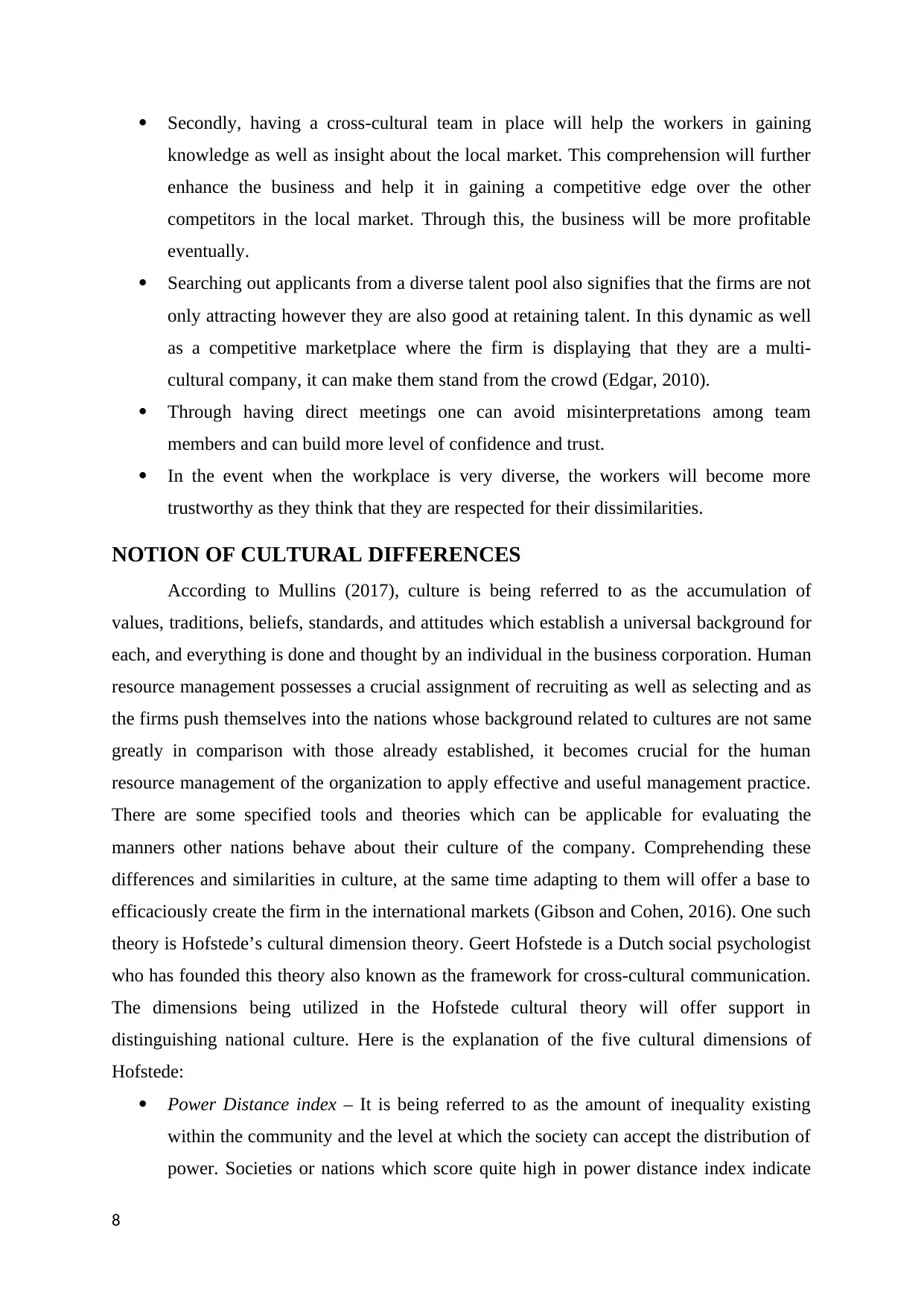
Secondly, having a cross-cultural team in place will help the workers in gaining
knowledge as well as insight about the local market. This comprehension will further
enhance the business and help it in gaining a competitive edge over the other
competitors in the local market. Through this, the business will be more profitable
eventually.
Searching out applicants from a diverse talent pool also signifies that the firms are not
only attracting however they are also good at retaining talent. In this dynamic as well
as a competitive marketplace where the firm is displaying that they are a multi-
cultural company, it can make them stand from the crowd (Edgar, 2010).
Through having direct meetings one can avoid misinterpretations among team
members and can build more level of confidence and trust.
In the event when the workplace is very diverse, the workers will become more
trustworthy as they think that they are respected for their dissimilarities.
NOTION OF CULTURAL DIFFERENCES
According to Mullins (2017), culture is being referred to as the accumulation of
values, traditions, beliefs, standards, and attitudes which establish a universal background for
each, and everything is done and thought by an individual in the business corporation. Human
resource management possesses a crucial assignment of recruiting as well as selecting and as
the firms push themselves into the nations whose background related to cultures are not same
greatly in comparison with those already established, it becomes crucial for the human
resource management of the organization to apply effective and useful management practice.
There are some specified tools and theories which can be applicable for evaluating the
manners other nations behave about their culture of the company. Comprehending these
differences and similarities in culture, at the same time adapting to them will offer a base to
efficaciously create the firm in the international markets (Gibson and Cohen, 2016). One such
theory is Hofstede’s cultural dimension theory. Geert Hofstede is a Dutch social psychologist
who has founded this theory also known as the framework for cross-cultural communication.
The dimensions being utilized in the Hofstede cultural theory will offer support in
distinguishing national culture. Here is the explanation of the five cultural dimensions of
Hofstede:
Power Distance index – It is being referred to as the amount of inequality existing
within the community and the level at which the society can accept the distribution of
power. Societies or nations which score quite high in power distance index indicate
8
knowledge as well as insight about the local market. This comprehension will further
enhance the business and help it in gaining a competitive edge over the other
competitors in the local market. Through this, the business will be more profitable
eventually.
Searching out applicants from a diverse talent pool also signifies that the firms are not
only attracting however they are also good at retaining talent. In this dynamic as well
as a competitive marketplace where the firm is displaying that they are a multi-
cultural company, it can make them stand from the crowd (Edgar, 2010).
Through having direct meetings one can avoid misinterpretations among team
members and can build more level of confidence and trust.
In the event when the workplace is very diverse, the workers will become more
trustworthy as they think that they are respected for their dissimilarities.
NOTION OF CULTURAL DIFFERENCES
According to Mullins (2017), culture is being referred to as the accumulation of
values, traditions, beliefs, standards, and attitudes which establish a universal background for
each, and everything is done and thought by an individual in the business corporation. Human
resource management possesses a crucial assignment of recruiting as well as selecting and as
the firms push themselves into the nations whose background related to cultures are not same
greatly in comparison with those already established, it becomes crucial for the human
resource management of the organization to apply effective and useful management practice.
There are some specified tools and theories which can be applicable for evaluating the
manners other nations behave about their culture of the company. Comprehending these
differences and similarities in culture, at the same time adapting to them will offer a base to
efficaciously create the firm in the international markets (Gibson and Cohen, 2016). One such
theory is Hofstede’s cultural dimension theory. Geert Hofstede is a Dutch social psychologist
who has founded this theory also known as the framework for cross-cultural communication.
The dimensions being utilized in the Hofstede cultural theory will offer support in
distinguishing national culture. Here is the explanation of the five cultural dimensions of
Hofstede:
Power Distance index – It is being referred to as the amount of inequality existing
within the community and the level at which the society can accept the distribution of
power. Societies or nations which score quite high in power distance index indicate
8
Paraphrase This Document
Need a fresh take? Get an instant paraphrase of this document with our AI Paraphraser
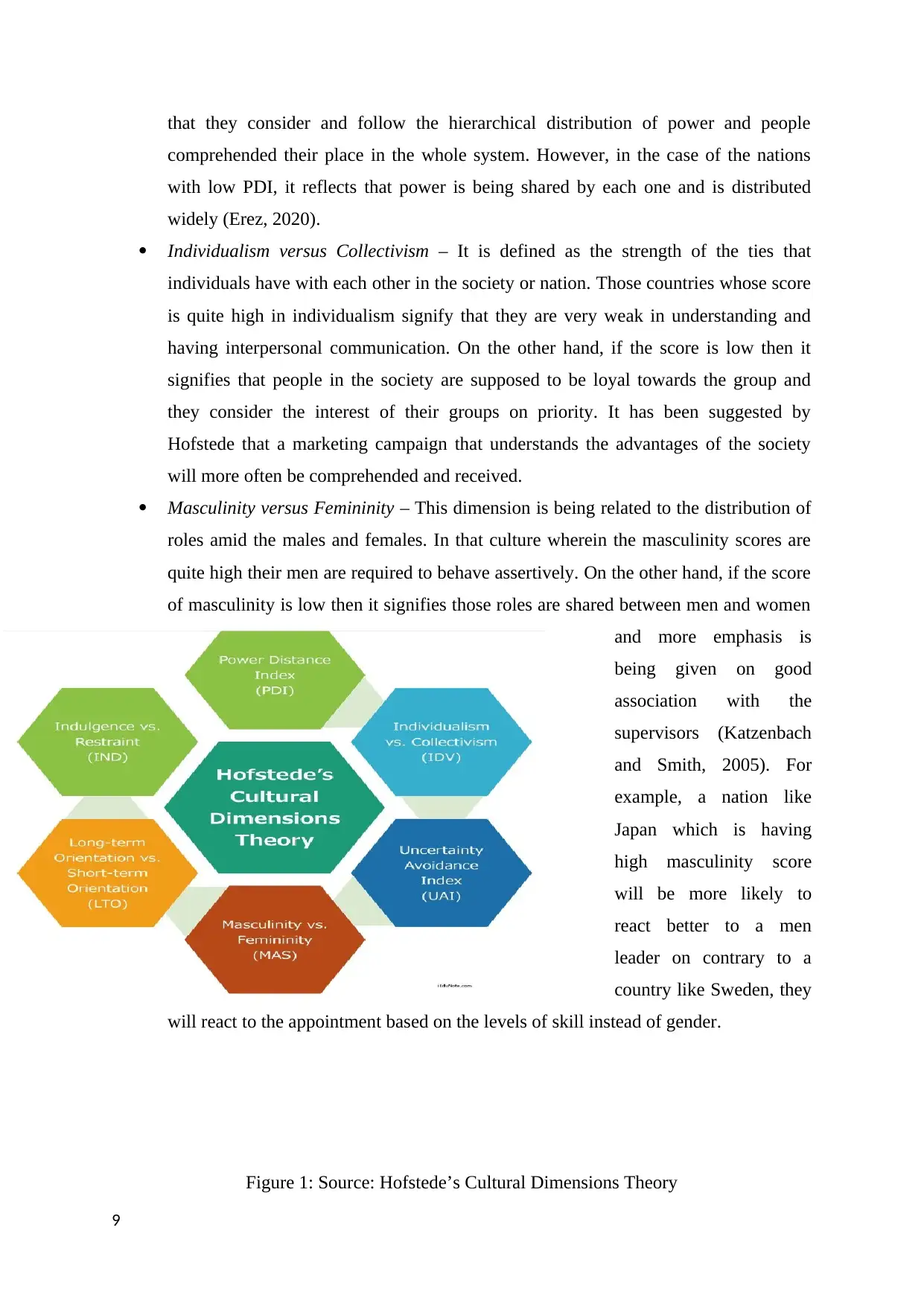
that they consider and follow the hierarchical distribution of power and people
comprehended their place in the whole system. However, in the case of the nations
with low PDI, it reflects that power is being shared by each one and is distributed
widely (Erez, 2020).
Individualism versus Collectivism – It is defined as the strength of the ties that
individuals have with each other in the society or nation. Those countries whose score
is quite high in individualism signify that they are very weak in understanding and
having interpersonal communication. On the other hand, if the score is low then it
signifies that people in the society are supposed to be loyal towards the group and
they consider the interest of their groups on priority. It has been suggested by
Hofstede that a marketing campaign that understands the advantages of the society
will more often be comprehended and received.
Masculinity versus Femininity – This dimension is being related to the distribution of
roles amid the males and females. In that culture wherein the masculinity scores are
quite high their men are required to behave assertively. On the other hand, if the score
of masculinity is low then it signifies those roles are shared between men and women
and more emphasis is
being given on good
association with the
supervisors (Katzenbach
and Smith, 2005). For
example, a nation like
Japan which is having
high masculinity score
will be more likely to
react better to a men
leader on contrary to a
country like Sweden, they
will react to the appointment based on the levels of skill instead of gender.
Figure 1: Source: Hofstede’s Cultural Dimensions Theory
9
comprehended their place in the whole system. However, in the case of the nations
with low PDI, it reflects that power is being shared by each one and is distributed
widely (Erez, 2020).
Individualism versus Collectivism – It is defined as the strength of the ties that
individuals have with each other in the society or nation. Those countries whose score
is quite high in individualism signify that they are very weak in understanding and
having interpersonal communication. On the other hand, if the score is low then it
signifies that people in the society are supposed to be loyal towards the group and
they consider the interest of their groups on priority. It has been suggested by
Hofstede that a marketing campaign that understands the advantages of the society
will more often be comprehended and received.
Masculinity versus Femininity – This dimension is being related to the distribution of
roles amid the males and females. In that culture wherein the masculinity scores are
quite high their men are required to behave assertively. On the other hand, if the score
of masculinity is low then it signifies those roles are shared between men and women
and more emphasis is
being given on good
association with the
supervisors (Katzenbach
and Smith, 2005). For
example, a nation like
Japan which is having
high masculinity score
will be more likely to
react better to a men
leader on contrary to a
country like Sweden, they
will react to the appointment based on the levels of skill instead of gender.
Figure 1: Source: Hofstede’s Cultural Dimensions Theory
9
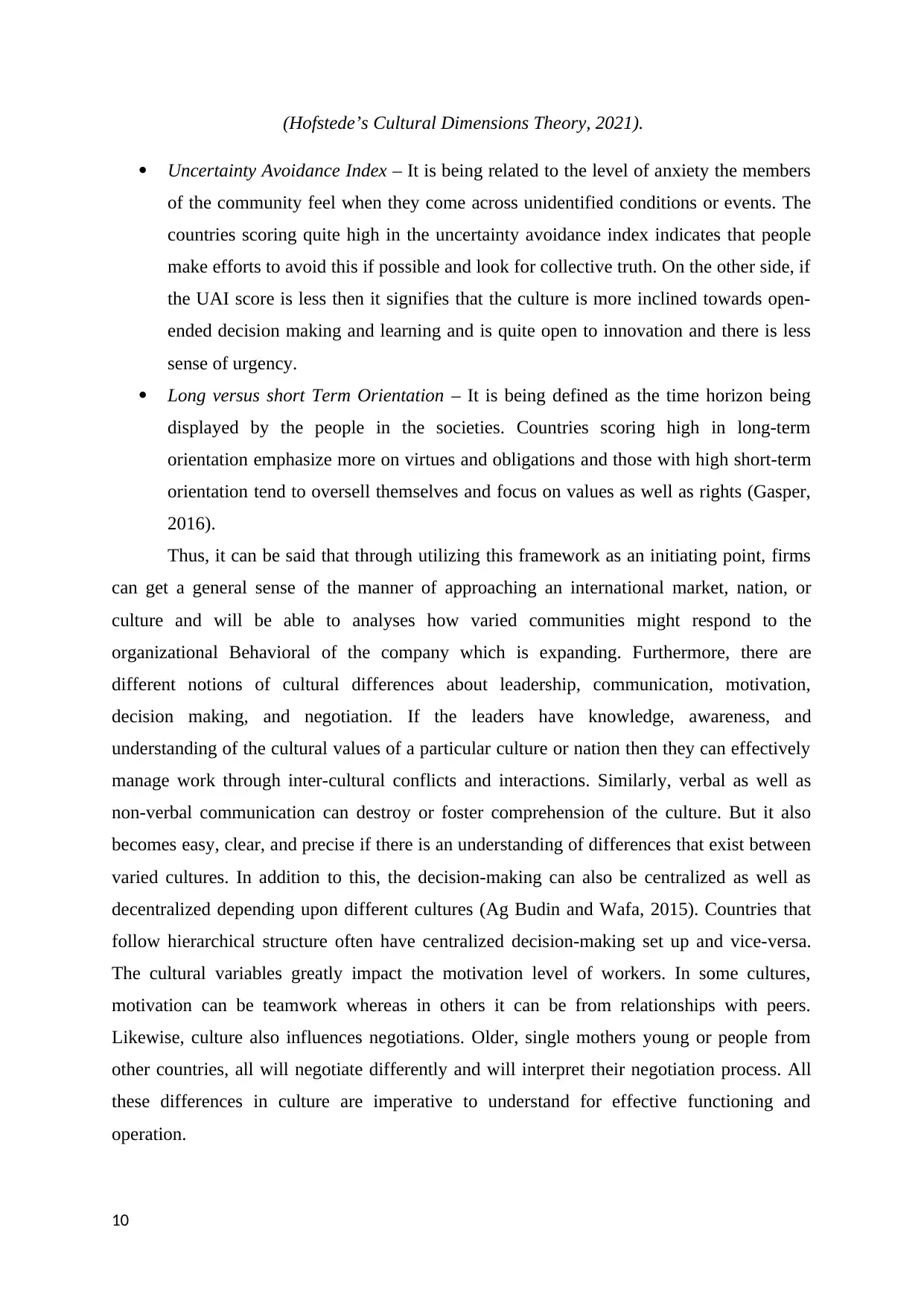
(Hofstede’s Cultural Dimensions Theory, 2021).
Uncertainty Avoidance Index – It is being related to the level of anxiety the members
of the community feel when they come across unidentified conditions or events. The
countries scoring quite high in the uncertainty avoidance index indicates that people
make efforts to avoid this if possible and look for collective truth. On the other side, if
the UAI score is less then it signifies that the culture is more inclined towards open-
ended decision making and learning and is quite open to innovation and there is less
sense of urgency.
Long versus short Term Orientation – It is being defined as the time horizon being
displayed by the people in the societies. Countries scoring high in long-term
orientation emphasize more on virtues and obligations and those with high short-term
orientation tend to oversell themselves and focus on values as well as rights (Gasper,
2016).
Thus, it can be said that through utilizing this framework as an initiating point, firms
can get a general sense of the manner of approaching an international market, nation, or
culture and will be able to analyses how varied communities might respond to the
organizational Behavioral of the company which is expanding. Furthermore, there are
different notions of cultural differences about leadership, communication, motivation,
decision making, and negotiation. If the leaders have knowledge, awareness, and
understanding of the cultural values of a particular culture or nation then they can effectively
manage work through inter-cultural conflicts and interactions. Similarly, verbal as well as
non-verbal communication can destroy or foster comprehension of the culture. But it also
becomes easy, clear, and precise if there is an understanding of differences that exist between
varied cultures. In addition to this, the decision-making can also be centralized as well as
decentralized depending upon different cultures (Ag Budin and Wafa, 2015). Countries that
follow hierarchical structure often have centralized decision-making set up and vice-versa.
The cultural variables greatly impact the motivation level of workers. In some cultures,
motivation can be teamwork whereas in others it can be from relationships with peers.
Likewise, culture also influences negotiations. Older, single mothers young or people from
other countries, all will negotiate differently and will interpret their negotiation process. All
these differences in culture are imperative to understand for effective functioning and
operation.
10
Uncertainty Avoidance Index – It is being related to the level of anxiety the members
of the community feel when they come across unidentified conditions or events. The
countries scoring quite high in the uncertainty avoidance index indicates that people
make efforts to avoid this if possible and look for collective truth. On the other side, if
the UAI score is less then it signifies that the culture is more inclined towards open-
ended decision making and learning and is quite open to innovation and there is less
sense of urgency.
Long versus short Term Orientation – It is being defined as the time horizon being
displayed by the people in the societies. Countries scoring high in long-term
orientation emphasize more on virtues and obligations and those with high short-term
orientation tend to oversell themselves and focus on values as well as rights (Gasper,
2016).
Thus, it can be said that through utilizing this framework as an initiating point, firms
can get a general sense of the manner of approaching an international market, nation, or
culture and will be able to analyses how varied communities might respond to the
organizational Behavioral of the company which is expanding. Furthermore, there are
different notions of cultural differences about leadership, communication, motivation,
decision making, and negotiation. If the leaders have knowledge, awareness, and
understanding of the cultural values of a particular culture or nation then they can effectively
manage work through inter-cultural conflicts and interactions. Similarly, verbal as well as
non-verbal communication can destroy or foster comprehension of the culture. But it also
becomes easy, clear, and precise if there is an understanding of differences that exist between
varied cultures. In addition to this, the decision-making can also be centralized as well as
decentralized depending upon different cultures (Ag Budin and Wafa, 2015). Countries that
follow hierarchical structure often have centralized decision-making set up and vice-versa.
The cultural variables greatly impact the motivation level of workers. In some cultures,
motivation can be teamwork whereas in others it can be from relationships with peers.
Likewise, culture also influences negotiations. Older, single mothers young or people from
other countries, all will negotiate differently and will interpret their negotiation process. All
these differences in culture are imperative to understand for effective functioning and
operation.
10
⊘ This is a preview!⊘
Do you want full access?
Subscribe today to unlock all pages.

Trusted by 1+ million students worldwide
1 out of 16
Related Documents
Your All-in-One AI-Powered Toolkit for Academic Success.
+13062052269
info@desklib.com
Available 24*7 on WhatsApp / Email
![[object Object]](/_next/static/media/star-bottom.7253800d.svg)
Unlock your academic potential
Copyright © 2020–2025 A2Z Services. All Rights Reserved. Developed and managed by ZUCOL.





